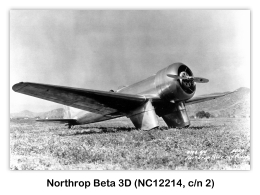
| ||||
|---|---|---|---|---|
 |
 |
 |
 |
 |



























| ||||
|---|---|---|---|---|
 |
 |
 |
 |
 |


























Northrop Beta 3D
Single-engine single-seat all-metal low-wing sport monoplane
Archive Photos
Northrop Beta 3D, X1224/NC12214, c/n 2, mfg 9/1931 (Northrop Aircraft Corporation photos from the Skytamer Archive)


Overview — Northrop Beta 3D
The first Northrop Alpha 2 was destroyed on 27 March 1930 during initial testing, and now the Northrop Beta 3 had met a similar end on 12 August 1931. For many depression-hit airplane manufacturers, the loss of the
.jpg) prototype aircraft meant failure and bankruptcy. But for Northrop, the set-Back had been overcome and seventeen Alphas had been built. It was Northrop’s intention to go ahead with the promising Beta design. Jack Northrop’s chief engineer, Donovan R. Don Berlin, already had a new version ready, with an engine of about twice the horsepower, a big Pratt & Whitney Wasp, Jr. This aircraft had only a single cockpit.
prototype aircraft meant failure and bankruptcy. But for Northrop, the set-Back had been overcome and seventeen Alphas had been built. It was Northrop’s intention to go ahead with the promising Beta design. Jack Northrop’s chief engineer, Donovan R. Don Berlin, already had a new version ready, with an engine of about twice the horsepower, a big Pratt & Whitney Wasp, Jr. This aircraft had only a single cockpit.
Shortly after the second Beta was completed at Burbank, the Northrop facility was consolidated with another United Aircraft division, the Stearman Aircraft Corporation of Wichita, Kansas. At this juncture, preferring to stay in CA, Jack Northrop resigned. He commented: ... it was a perfectly logical move, but ... my family came from Nebraska to CA, and I wasn’t about to move to Kansas. Plans to continue Alpha and Beta aircraft manufacturer were begun by the transfer to Wichita of Northrop assets, machinery, and materials. The second Beta went along with the move.
The Stearman Corporation ran further tests of the Beta, now called a Model 3D. The evaluation proceeded, again with Eddie Allen, and he had the satisfaction of seeing the Beta 3D given a Group 2 Approved Type Certificate on 2 February 1932.
The little single-placed Beta 3D was sold to Kenyon Boocock, a New York City sportsman pilot. Undertaking the delivery flight from Wichita, Eddie Allen got a stiff tail wind and said he averaged better than 200 mph on cross-country. At a stop at Wright Field in Dayton, Ohio, Army Air Corps engineers spent a cold February day going over the Beta 3D, "with a view to its potential usefulness for military work." Their cameras, slide rules, and calipers recorded the shape of things to come. Here were all makings of the all-metal fighter monoplane of the next decade. But in 1932, the Army was still oriented towards frame-and-fabric biplanes. By the time Mr. Boocock bought the airplane, it had a new raised fairing from cockpit to tail fin and was called a Stearman Beta. The New Yorker and enclosed the cockpit and coaxed the top speed up to 212 mph, but he didn’t fly the little Beta very often. The Beta was up for sale in December 1932 with a total time of only 129 hours. At a price of $5,000, Boocock found a buyer in George W. Hard, the twenty-year-old son of a Manhattan broker.
Mr. Hard took delivery of the Stearman Beta at Roosevelt Field and the same day hopped it over to the Long Island Aviation Country Club field at Hicksville. During landing, the plane and pilot went through a fence and ended up in an inverted position on the Long Island Parkway. The young Mr. Hard crawled out unhurt. With wing and other damage, the Northrop-Stearman was stored and then sold Back to United Aircraft. The Stearman shop rebuilt it in Wichita, intending to experiment with Zap, Fowler and Wright flaps. However, an accident the day after re licensing completely destroyed the aircraft. Further production of Northrop Alphas and Betas was never undertaken by United Aircraft & Transport’s Stearman division in Wichita. Jack Northrop, Don Berlin, and many of the old employees of the United subsidiary at Burbank never left CA.
Northrop’s former benefactor, Donald W. Douglas, had more than he could handle in military orders at the Douglas plant in Santa Monica. The two friends arranged the organization of yet another firm, The Northrop Corporation, founded 1 January 1932, as a subsidiary of Douglas Aircraft Company, Inc. John K. Northrop was named president and Ken Jay vice-president, and Don R. Berlin continued as chief engineer. Berlin had able assistance from John Clifford Garrett as purchasing agent, Arthur Mankey as chief draftsman, and Gage H. Irving as pilot-salesman. The new manufacturing site was found, a small factory formerly occupied by the White Truck and the Moreland Aircraft companies, situated on Mines Field in Inglewood, CA. Plans for the Northrop subsidiary of Douglas called for the building of innovative, experimental aircraft.
Specifications Northrop Beta 3D
Type
Wings
Fuselage
Tail Unit
Undercarriage
Power Plant
Accommodation
Dimensions
Weights and Loadings
Performance (Estimated)
References